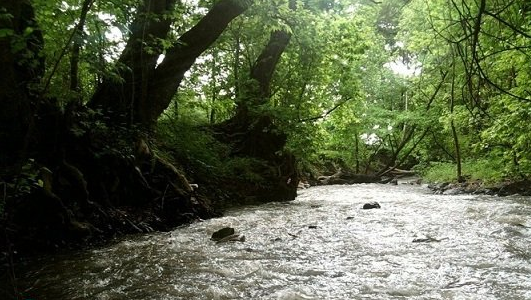Basitchay: Sign of ecological revival in liberated lands

By Vugar Khalilov
Azerbaijan has 14 officially-registered state reserves and 20 sanctuaries.
The creation of reserves and sanctuaries aims to protect and restore rare landscapes, valuable animal and plant species, standard natural ecosystems, as well as creatures that are specific for a certain region.
In this regard, the establishment of the Basitchay State Nature Reserve represents a watershed moment for the preservation and promotion of the eastern plane tree, one of Azerbaijan's unique jewels.
The 107-hectare reserve was established in 1974 to protect a unique plane tree (sycamore), which has been listed in Azerbaijan's Red Book as endangered species due to its scarcity in the world and significant decline in its number in the recent centuries.
Located in the Zangilan region along the Basitchay River in the south-eastern part of the Lesser Caucasus, the reserve is 15 kilometers long and 150-200 meters wide and is bordered by simple arid forests.
Post-war ecological revival
After the liberation of Azerbaijani territories from Armenia's occupation in the 44-day war in 2020, President Ilham Aliyev visited the Basitchay State Nature Reserve in Zangilan region in February 2021.
Aliyev stressed the ecological terror committed by Armenian invaders in the Basitchay reserve and in other occupied lands during the three-decade occupation. He noted that the Armenians had destroyed almost half of the forest area of the reserve and burned the roots and firewood of the trees.
Aliyev planted plane trees in the reserve and released fish to the Basitchay River. He emphasized that the restoration of the Basitchay Nature Reserve has started and Azerbaijan will restore the reserve.
He recalled that Armenia had blocked the rivers, which left other Azerbaijani regions waterless and that Armenia had been committing environmental terror against Azerbaijan over the past 30 years.
On October 20, 2021, Aliyev signed a decree on the restoration of the Basitchay State Reserve located on Zangilan, part of the Eastern Zangazur economic region.
The decree aims to improve the environment and ensure sustainable use of natural resources on the liberated territories, to preserve the network of specially protected natural areas, rare natural complexes, and objects in their natural state.
Flora and fauna
Plane trees, which make up 93.5 percent of the Basitchay reserve, are the most prevalent natural species in the Basitchay valley and the average age of the sycamore trees is around 170 years. However, the reserve also hosts 1200-1500-year-old giant trees, which sometimes reach 50 meters in height and four meters in diameter.
There are Georgian oaks and Caucasian hornbeams on the right bank of the Basitchay, and juniper bushes, various species of old plane trees, on the left bank of the Basitchay gorge.
Furthermore, walnut, mountain ash, mulberry, willow, poplar, hawthorn, and other sorts of trees and bushes are spread in the area of the reserve.
Wolves, wild boars, badgers, roe deer, rabbits, numerous rodents, animals, partridges, pigeons, and other bird species are seen in the reserve and surrounding areas.
Landscape and climate
The reserve's territory is mainly mountainous with an altitude of 600-800 meters above sea level. The right bank of the river consists of mountains with steep slopes, while the left bank entails hills.
Tertiary sediments are widespread. A narrow alluvial plain stretches along the river valley and the mountains in the area are greatly divided by the Basitchay tributaries.
The reserve area belongs to the temperate-hot climate type with dry winters. The average annual temperature is 13 degrees and annual precipitation reaches 600 mm. The area's climatic conditions are very favorable for the natural regeneration and development of plane trees.
Alluvial-forest lands and brown mountain-forest soils are mainly spread in the reserve and in the surrounding areas. Alluvial soils developed along the riverbed and on small terraces, which remain mainly under the sycamore forests.
Armenian ecoterrorism
For decades, Armenia had been able to keep the occupied territories out of Azerbaijan’s, as well, the international communities’ control. The territories beyond control became a secret haven for Armenian criminals and provided opportunities for their illegal activities contrary to international conventions, including the plundering of natural resources, the pollution of water resources, and the destruction of flora.
The natural ecosystem's environmental balance, which had formed here over the years, has been seriously undermined as a result of Armenian vandalism.
Armenians have completely destroyed and ruthlessly uprooted 200-year-old plane trees, which are considered to be Basuitchay's main natural complex.
The monitoring group visiting the liberated lands revealed that Armenia had completely destroyed over 42 hectares of the reserve's 85-hectare forested area.
Perennial valuable oriental plane trees were cut down, various explosives were used to lose their roots, fires were started in the area and the administrative building of the reserve was destroyed.
--
Follow us on Twitter @AzerNewsAz
Here we are to serve you with news right now. It does not cost much, but worth your attention.
Choose to support open, independent, quality journalism and subscribe on a monthly basis.
By subscribing to our online newspaper, you can have full digital access to all news, analysis, and much more.
You can also follow AzerNEWS on Twitter @AzerNewsAz or Facebook @AzerNewsNewspaper
Thank you!
